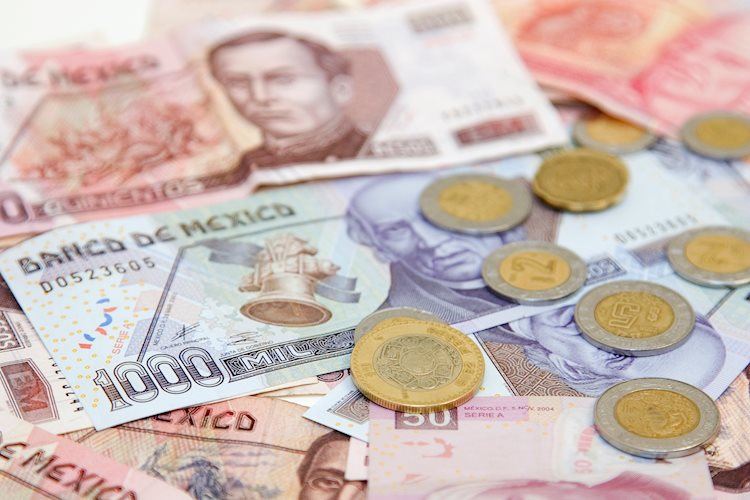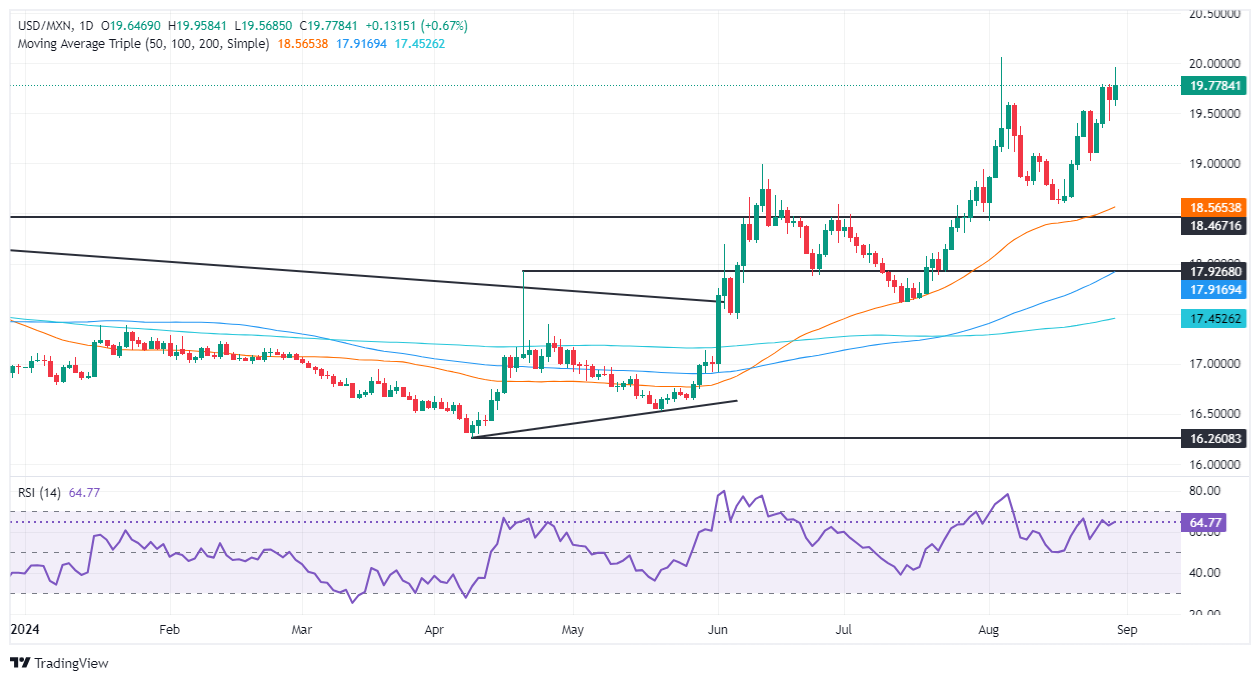- Mexican Peso declines as Banxico cuts 2024, 2025 GDP forecast.
- Political unrest over judiciary reform and dismantling of autonomous bodies further pressures the Peso.
- Banxico sees inflation reaching 3% target by late 2025, with growth risks skewed downward due to slowing US economy.
The Mexican Peso depreciated against the Greenback on Thursday, with the latter extending its gains for the second straight day on robust US data. Meanwhile, the emerging market currency dropped after the Bank of Mexico (Banxico) revised Mexico’s growth expectations to the downside for the rest of 2024, according to its quarterly report. The USD/MXN trades at 19.77 and gains over 0.70%.
Mexico’s political turmoil continues to dampen the prospects of the Mexican currency. President-elect Claudia Sheinbaum reassured foreign investors that their investments are secure, even though she approves the judiciary reform and the bill for the dissolution of autonomous bodies pushed by President Andres Manuel Lopez Obrador.
In addition, Banxico downwardly revised the Gross Domestic Product (GDP) for 2024 from 2.4% to 1.5% and from 1.5% to 1.2% for 2025 after revealing its Q2 2024 quarterly revision.
In the report, policymakers mentioned that “national economic activity is going through a period of market weakness and uncertainty.” They revisited inflation expectations higher and expect it to hit the bank’s 3% goal toward the end of 2025.
Furthermore, they added that risks to growth are tilted to the downside, adding that an economic deceleration in the US economy weighs on Mexico’s economic outlook.
Banxico Governor Victoria Rodriguez Ceja warned that adjustments to the main reference rates would be gradual only when macroeconomic conditions allowed them.
Across the border, the US Bureau of Economic Analysis (BEA) upwardly revised the second estimate for Gross Domestic Product (GDP). At the same time, the US Department of Labor revealed that the number of Americans filing for unemployment benefits dipped.
Daily digest market movers: Mexican Peso collapses as AMLO pauses relations with US-Canada ambassadors
- Mexican President Andres Manuel Lopez Obrador’s decision to pause relations with the US and Canadian ambassadors this wee will continue to weigh on the Mexican Peso.
- Comments from US Ambassador Ken Salazar, expressed on August 22, were the reason behind AMLO’s decision. Salazar said that the judiciary reform threatens the rule of law and added that “the direct election of judges represents a major risk to the functioning of Mexico’s democracy. Any judicial reform must have safeguards that guarantee that the judiciary is strengthened and not subject to the corruption of politics.”
- US GDP for Q2 2024 saw a second estimate that jumped from 1.4% in Q1 to 3%, exceeding estimates of 2.8%. The Personal Consumption Price Expenditures (PCE) Deflator hinted that inflation dipped from 3.1% to 2.5% QoQ, slightly higher than the 2.3% foreseen.
- Initial Jobless Claims for the week ending August 24 dipped from 233K to 231K, below estimates of 232K.
- Traders will eye Fed speakers and the Fed’s preferred inflation gauge, the core Personal Consumption Expenditures Price Index (PCE), which arrives on Friday.
- Data from the Chicago Board of Trade (CBOT) suggests the Fed will cut at least 98 basis points (bps), according to the fed funds rate futures contract for December 2024.
Technical outlook: Mexican Peso slumps as USD/MXN hits two-week high at 19.95
The USD/MXN is at the risk of decisively clearing the 20.00 hurdle. From a technical standpoint, the uptrend remains intact as the Peso, although it has achieved some positive days, continues to register more significant losses.
The Relative Strength Index (RSI) suggests that buyers are in charge. The RSI is still bullish but not in overbought territory.
Therefore, the path of least resistance is to the upside. The USD/MXN first resistance would be 20.00. A breach of that level will expose the year-to-date (YTD) high at 20.22, followed by the September 28, 2022, daily high at 20.57. If those two levels are surrendered, the next stop would be the August 2, 2022, swing high at 20.82, ahead of 21.00.
Conversely, if USD/MXN tumbles below 19.50, this would expose the 19.00 figure. Further losses lie beneath that level, opening the door to test the August 19 low of 18.59, followed by the 50-day Simple Moving Average (SMA) at 18.48.
Risk sentiment FAQs
In the world of financial jargon the two widely used terms “risk-on” and “risk off” refer to the level of risk that investors are willing to stomach during the period referenced. In a “risk-on” market, investors are optimistic about the future and more willing to buy risky assets. In a “risk-off” market investors start to ‘play it safe’ because they are worried about the future, and therefore buy less risky assets that are more certain of bringing a return, even if it is relatively modest.
Typically, during periods of “risk-on”, stock markets will rise, most commodities – except Gold – will also gain in value, since they benefit from a positive growth outlook. The currencies of nations that are heavy commodity exporters strengthen because of increased demand, and Cryptocurrencies rise. In a “risk-off” market, Bonds go up – especially major government Bonds – Gold shines, and safe-haven currencies such as the Japanese Yen, Swiss Franc and US Dollar all benefit.
The Australian Dollar (AUD), the Canadian Dollar (CAD), the New Zealand Dollar (NZD) and minor FX like the Ruble (RUB) and the South African Rand (ZAR), all tend to rise in markets that are “risk-on”. This is because the economies of these currencies are heavily reliant on commodity exports for growth, and commodities tend to rise in price during risk-on periods. This is because investors foresee greater demand for raw materials in the future due to heightened economic activity.
The major currencies that tend to rise during periods of “risk-off” are the US Dollar (USD), the Japanese Yen (JPY) and the Swiss Franc (CHF). The US Dollar, because it is the world’s reserve currency, and because in times of crisis investors buy US government debt, which is seen as safe because the largest economy in the world is unlikely to default. The Yen, from increased demand for Japanese government bonds, because a high proportion are held by domestic investors who are unlikely to dump them – even in a crisis. The Swiss Franc, because strict Swiss banking laws offer investors enhanced capital protection.

